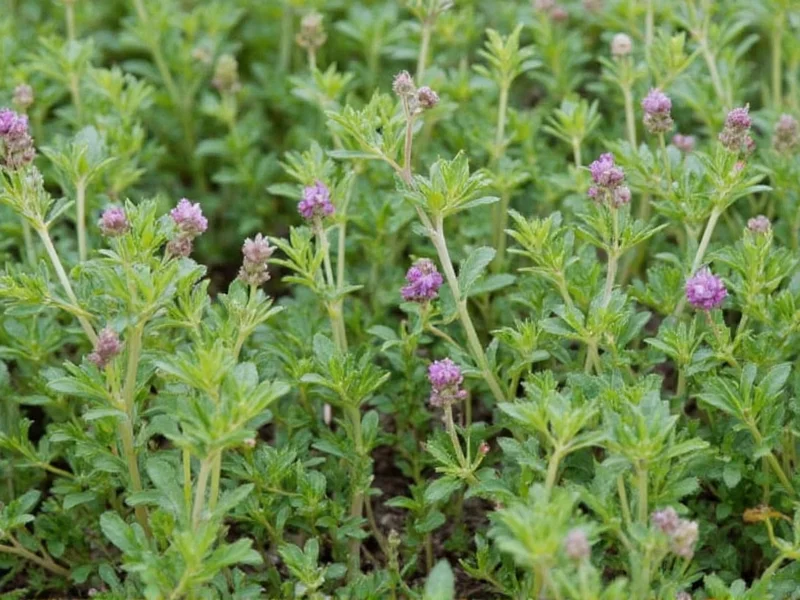Plant thyme by selecting a sunny location with well-draining soil (pH 6.0-8.0). Sow seeds 1/4 inch deep indoors 6-8 weeks before last frost or transplant seedlings 12-18 inches apart after danger of frost passes. Water lightly after planting, avoiding overwatering. Thyme thrives in poor soil with minimal care once established. Space plants 12-24 inches apart depending on variety for optimal growth and air circulation.
Complete Guide to Planting Thyme Successfully
Thyme isn't just a kitchen staple—it's one of the most resilient and rewarding herbs to grow in your garden. Whether you're a beginner gardener or expanding your herb collection, understanding how to plant thyme properly ensures a thriving, aromatic harvest. This comprehensive guide covers everything you need to know about planting thyme successfully, from timing to technique.Understanding Thyme Varieties and Their Planting Needs
Not all thyme is created equal. Different varieties have slightly different planting requirements:- English thyme (Thymus vulgaris): The most common culinary variety, prefers full sun and excellent drainage
- Lemon thyme (Thymus citriodorus): Needs slightly more moisture but still requires good drainage
- Creeper thyme (Thymus serpyllum): Ideal as ground cover, tolerates foot traffic
- Woolly thyme: Ornamental variety that prefers drier conditions
Optimal Timing for Planting Thyme
The best time to plant thyme depends on your climate zone and whether you're starting from seeds or transplants:- From seeds indoors: Start 6-8 weeks before your last expected frost date
- Direct seeding outdoors: After soil reaches 70°F (21°C), typically 2-3 weeks before last frost
- Transplanting seedlings: 2-3 weeks after last frost when soil has warmed
- Fall planting: 6-8 weeks before first frost for establishment before winter
Soil Preparation: Creating the Perfect Environment
Thyme thrives in conditions that would challenge many other herbs. Proper soil preparation is crucial for successful thyme planting:- Drainage is critical: Amend heavy soils with sand or gravel (up to 30% by volume)
- pH balance: Aim for slightly alkaline to neutral soil (6.0-8.0)
- Nutrient levels: Thyme prefers poor soil—avoid rich compost or heavy fertilization
- Soil texture: Sandy or rocky soils work best; clay soils require significant amendment
| Planting Specification | Seed Planting | Transplanting |
|---|---|---|
| Planting Depth | 1/4 inch | Same depth as container |
| Spacing Requirements | 6 inches apart initially | 12-24 inches apart |
| Soil Temperature | 70°F (21°C) | 60°F+ (15°C+) |
| Watering After Planting | Light misting | Thorough but not soggy |
| Time to Germination | 14-28 days | N/A |
Step-by-Step Thyme Planting Process
Follow these detailed steps whether you're planting thyme seeds or transplants:For Seed Planting:
- Fill seed trays with seed starting mix or a 50/50 blend of potting soil and perlite
- Sow seeds on surface and cover with 1/4 inch of soil (thyme needs light to germinate)
- Mist soil to moisten without disturbing seeds
- Cover trays with plastic to maintain humidity
- Place in warm location (70-75°F/21-24°C) with indirect light
- Remove cover once sprouts appear (typically 14-21 days)
- Gradually increase sunlight exposure over 7-10 days
- Harden off seedlings for 7-10 days before transplanting outdoors
For Transplanting Established Plants:
- Dig hole twice as wide as root ball but same depth
- Gently loosen roots if rootbound
- Place plant in hole, ensuring crown sits at soil level
- Backfill with native soil, avoiding amendments
- Water thoroughly but avoid creating a muddy environment
- Apply light mulch (straw or gravel) to conserve moisture
Post-Planting Care for Healthy Thyme
Proper care immediately after planting ensures your thyme establishes successfully:- Watering schedule: Water only when top inch of soil feels dry—thyme prefers drought conditions
- Sunlight requirements: Minimum 6 hours of direct sun daily (8+ hours ideal)
- First-season pruning: Pinch back growing tips when plants reach 3 inches tall
- Fertilizing: Avoid during first year; mature plants need only light feeding in spring
- Winter preparation: In cold climates, apply light mulch after first hard frost
Avoiding Common Thyme Planting Mistakes
Even experienced gardeners encounter challenges when planting thyme. Watch for these common issues:- Overwatering: Causes root rot—thyme prefers dry conditions
- Poor drainage: The #1 reason for failed thyme plantings
- Excessive fertilization: Reduces essential oil concentration and flavor
- Insufficient spacing: Leads to poor air circulation and disease
- Planting too deep: Especially problematic with seedlings
Troubleshooting Early Growth Problems
If your thyme isn't thriving after planting, check these common issues:- Yellowing leaves: Usually indicates overwatering—reduce frequency immediately
- Leggy growth: Not enough sunlight—move to a sunnier location
- Slow germination: Seeds may be too deep or soil too cold
- Mold on soil surface: Decrease humidity and increase air circulation
- Poor establishment: May need better drainage or less fertile soil











 浙公网安备
33010002000092号
浙公网安备
33010002000092号 浙B2-20120091-4
浙B2-20120091-4